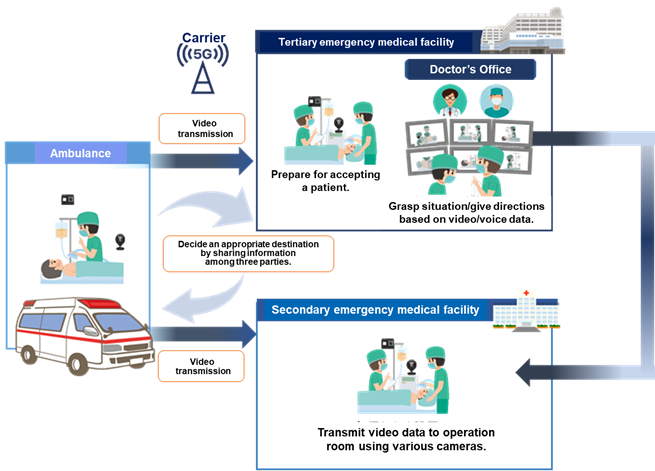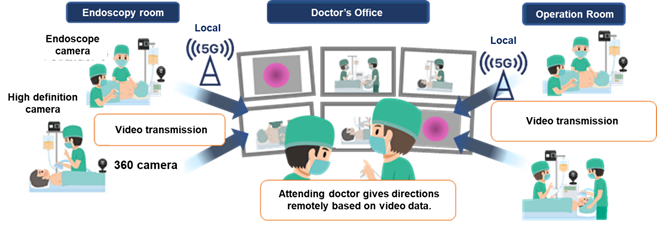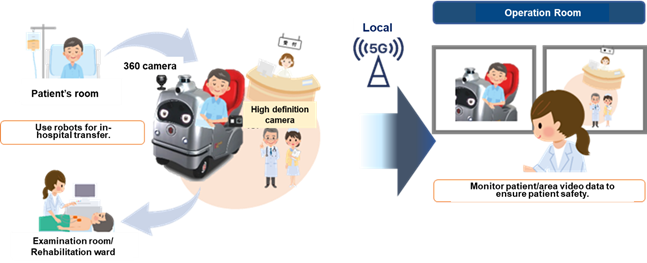DEC
St. Marianna University School of Medicine, Kawasaki Municipal Tama Hospital, and Kawasaki City Fire Department launch a demonstration experiment using local 5G and other cutting-edge technology. Aim to build use cases for next-generation medical services.
November 30, 2022
Kawasaki City
transcosmos inc.
St. Marianna University School of Medicine
NTT Communications Corporation
transcosmos inc. (transcosmos), St. Marianna University School of Medicine (St. Marianna University Hospital), NTT Communications Corporation (NTT Com), and Kawasaki City hereby announce that the four parties will begin a demonstration experiment (the experiment) to create use cases for next-generation medical services using local 5G (the fifth generation of cellular technology) and other cutting-edge technologies on Wednesday, December 7, 2022. The experiment will be conducted at an inpatient ward, which St. Marianna University Hospital will open in Kawasaki city, and Kawasaki Municipal Tama Hospital using Kawasaki City Fire Department’s ambulance services.
The experiment has been chosen by the Ministry of Internal Affairs and Communications for its public appeal for “The fiscal 2022 development demonstrations for realizing local 5G services to solve issues.”
1. Background
Medical institutions in urban cities constantly face a shortage of doctors due to an increasing demand for receiving emergency outpatients, and for performing operations and examinations. The institutions are required to enhance systems to receive emergency outpatients appropriately, and at the same time, they must always retain and increase the quality of medical care while complying with doctor’s overtime regulations which will take effect in 2024. To create a more worker-friendly environment for healthcare professionals where they can focus more on medical care under the given situation, it is essential for the healthcare industry to reduce doctors’ and nurses’ workload.
2. Overview of the Experiment
The purpose of the experiment is to contribute to the healthcare industry in solving the challenges it faces such as a shortage of medical doctors and heavy workload on nurses and other healthcare professionals. To achieve this goal, the four parties will build use cases for next-generation medical services using cutting-edge technologies including 5G and autonomous mobile robots.
3. Future Plan
The four parties plan to implement systems used in the experiment to St. Marianna University Hospital. In a longer perspective, the parties aim to deploy use cases built in the experiment to wider areas in Japan. Also, the parties will report the findings of the experiment to the Japanese government, and present the case in academic conferences in order to contribute to medical institutions across Japan in resolving their challenges such as a shortage of medical doctors and their heavy workloads.
| Media Contacts | |
|---|---|
| Government Relations & Public Affairs Division transcosmos inc. TEL: +81-3-6709-2251 |
Digital Health Co-creation Center St. Marianna University School of Medicine TEL: +81-44-977-8111 |
| NTT Communications Corporation TEL: +81-45-226-8041 |
Healthcare Policy Office, Health and Welfare Center Kawasaki City TEL: +81-44-200-2420 |
Demonstration Experiment Overview: Build Use Cases to Create Next-Gen Medical Services with Local 5G and other Advanced Technologies
(1) Summary
The four parties will conduct the experiment under three themes with the aim of building use cases for next-generation medical services that utilize cutting-edge technologies including 5G.
(2) Period
Wednesday, December 7, 2022 to Monday, December 26, 2022
(Local governments and healthcare professionals’ visit to St. Marianna University Hospital (Kawasaki city, Kanagawa prefecture) is scheduled on Monday, December 26, 2022.)
(3) Abstracts (refer to Reference for illustrations and details of the experiment)
| Themes | Points to be verified | Equipment/ Technologies |
|---|---|---|
| Strengthen community medical institution communication network with real-time video transmission during ambulance transfer using carrier 5G. | Verify the time spent on deciding destination, and accuracy and efficiency of communication, etc. | ・5G network ・360 cameras ・Wearable cameras ・4K cameras |
| Provide remote medical support using local 5G. | Verify changes in attending doctor’s work hours associated with the use of remote assistance process for endoscopic examination, intubation, etc. | ・5G network ・Endoscope cameras ・360 cameras ・Wearable cameras ・4K cameras |
| Reduce workloads for patient transfer using autonomous mobile robots. | Verify nurses’ and other staff’s time spent on patient transfer from patient room to examination rooms and rehabilitation wards, etc. | ・5G network ・Autonomous mobile robots ・360 cameras ・4K cameras |
(4) Main Roles and Responsibilities of Each Party
| Company/Organization | Main Roles and Responsibilities |
|---|---|
| transcosmos | ・Overall management of the experiment. |
| St. Marianna University Hospital |
・Prepare and offer areas for the field experiment. |
| NTT Com | ・Build systems for the experiment. |
| Kawasaki City |
・Prepare and offer areas for the field experiment (Kawasaki Municipal Tama Hospital), and provide medical service resources (ambulances and paramedics). ・Attend the experiment and exchange opinions from the perspective of an organization responsible for emergency transportation. ・Assist in sharing the results of the experiment to hospitals in the city. |
*Planned period and content of the experiment are subject to change due to the latest situation of COVID-19 infection.
Details of Each Theme
(1) Strengthen community medical institution communication network with real-time video transmission during ambulance transfer using carrier 5G.
| Current Status | Community medical institutions in charge of secondary*1 and tertiary emergency medical care*2 communicate with ambulances via voice, using mobiles and other equipment. |
| Experiment Theme Details |
Transmit videos from an ambulance showing a patient and inside the ambulance during emergency transfer to the community secondary and tertiary emergency medical facilities via high definition cameras using carrier 5G. Verify the effect on enhancing and streamlining processes for community medical institutions to decide an appropriate destination and to prepare for receiving patients. |
| Expected Benefit | Reduce time and enhance processes to decide an appropriate destination and to prepare for receiving patients. |

*1: Secondary emergency medical care institutions provide care for patients in severe conditions who need operations and hospitalization. Kawasaki Municipal Tama Hospital falls under this category in the experiment.
*2: Tertiary emergency medical care institutions receive critically ill patients and patients with specified diseases to whom secondary emergency medical care institutions cannot provide appropriate care. St. Marianna University Hospital falls under this category in the experiment.
(2) Provide remote medical support using local 5G.
| Current Status | Attending doctors visit an endoscopic examination room for examination and diagnosis, and an operation room for intubation every time. |
| Experiment Theme Details |
Transmit videos from the endoscopic examination room and operation room to the attending doctor’s office where the doctor stands waiting via high definition cameras, 360 cameras and endoscope cameras so that the doctors can give directions remotely. Verify the effect on the doctor’s operational efficiency and the quality of medical services. |
| Expected Benefit | Enable task shifting and reduce working hours of attending doctors who provide assistance from their office. |

(3) Reduce workloads required for patient transfer using autonomous mobile robots.
| Current Status | Doctors and nurses assist patient transfer from patient rooms to examination rooms and rehabilitation wards. Nearly 1,500 transfers take place in the entire St. Marianna University Hospital every day. |
| Experiment Theme Details |
Utilize autonomous mobile robots, local 5G, high definition cameras, 360 cameras and other tools to transfer patients safely and securely from their rooms to examination rooms and rehabilitation wards. Verify the effect on working hours of doctors and nurses. |
| Expected Benefit | Reduce working hours of doctors and nurses associated with patient transfers. Make the transfer easier and more comfortable for patients without sacrificing safety and security. |






